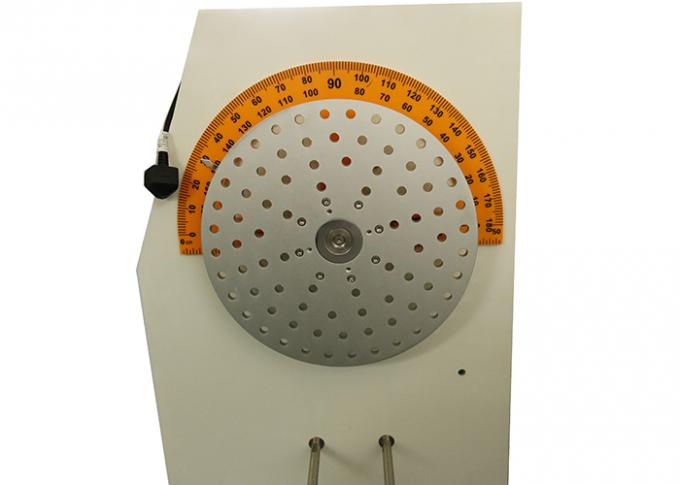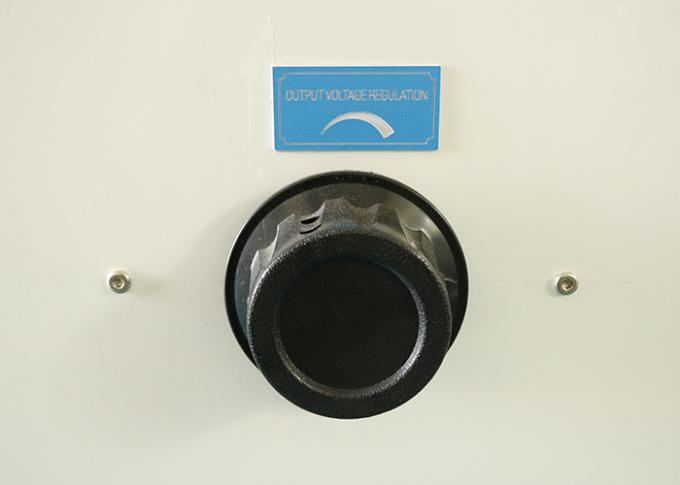Cord Flexing Test 0-360 ° Single Station Machine IEC60335 For Household Appliance
Cord Flexing Test 0-360 ° Single Station Machine IEC60335 For Household Appliance
- Model:
Cord Flexing Test 0-360 ° Single Station Machine IEC60335 For Household Appliance
IEC60335 PLC Control Cord Flexing Test 0-360 ° Single Station Machine For Household Appliance
Product Introduction
The Household Appliance Supply Cord Flexing Test Apparatus is special designed and manufactured according to IEC60335-1, GB4706-1, IEC60335-2-14, GB4706-30 clause 23.3 and 25.14 and etc., it is used to check the power cord flexing (bending) resistance performance of the small household appliances (such as Coffee pot / electric iron) and lamps, also applicable for power cord flexing endurance tester of plugs and sockets.
The test device adopts to PLC electrical control, 7 inch color touch screen intelligent operation system; servo motor controlling the test angle, high precision digital instrument, high performance digital frequency conversion, precise speed regulation, six number memory timer, multifunctional combined clamp, center gage of rotation, bending angle adjustable, 4kw output power. Test times (maximum of 999999 times), test speed, and test angles can be preset; it has electric current detection function. This device can meet the test requirements of most of small household electrical appliances, the applicable range is widely.
Technical Parameters
| Item Name | Parameters |
| Flexing angle | Left 0-360°; right 0-360°. Can be preset |
| Flexing speed | Flexing speed 0~60 rpm, can be preset |
| Test times | 0~999999 times, can be preset and displayed |
| Power | 110V 60Hz |
| Control | PLC programmable control |
| Drive | Servo motor |
| Operation | Touch screen intelligent operation |
| Configuration | 0~4KW transformer, test current display |
| Bearing | Max. 10kg |
| Test station | 1 station |
| Specimen fixture | Universal fixtures, with center gage of rotation |
| Load weights | 5N*1,10N*1 |
| Standards | IEC 60335-1, IEC 60335-2-14, GB4706.1, GB2099 |
Standard Description
23.3 Different parts of an appliance that can move relative to each other in normal use or during user maintenance shall not cause undue stress to electrical connections and internal conductors, including those providing earthing continuity. Flexible metallic tubes shall not cause damage to the insulation of the conductors contained within them. Open-coil springs shall not be used to protect the wiring. If a coiled spring, the turns of which touch one another, is used for this purpose, there shall be an adequate insulating lining in addition to the insulation of the conductors.
NOTE 1 The sheath of a flexible cord complying with IEC 60227 or IEC 60245 is regarded as an adequate insulating lining.
Compliance is checked by inspection and by the following test.
If flexing occurs in normal use, the appliance is placed in the normal position of use and is supplied at rated voltage and operated under normal operation.
The movable part is moved backwards and forwards, so that the conductor is flexed through the largest angle allowed by the construction, the rate of flexing being 30 per minute. The
number of flexings is
− 10 000, for conductors flexed during normal use;
− 100, for conductors flexed during user maintenance.
NOTE 2 A flexing is one movement, either backwards or forwards.
The appliance shall not be damaged to the extent that compliance with this standard is impaired and it shall be fit for further use. In particular, the wiring and its connections shall withstand the electric strength test of 16.3, the test voltage being reduced to 1 000 V and applied between live parts and accessible metal parts only.
25.14 Appliances provided with a supply cord that are moved while in operation shall be
constructed so that the supply cord is adequately protected against excessive flexing where it enters the appliance.
NOTE 1 This does not apply to appliances with automatic cord reels that are tested by 22.16 instead.
Compliance is checked by the following test that is carried out on an apparatus having an oscillating member as shown in figure 8.
The part of the appliance that includes the inlet opening is fixed to the oscillating member so that, when the supply cord is at the middle of its travel, the axis of the cord where it enters
the cord guard or inlet is vertical and passes through the axis of oscillation. The major axis of the section of flat cords shall be parallel to the axis of oscillation.
The cord is loaded so that the force applied is
– 10 N, for cords having a nominal cross-sectional area exceeding 0,75 mm²;
– 5 N, for other cords.
The distance X, as shown in figure 8, between the axis of oscillation and the point where the
cord or cord guard enters the appliance, is adjusted so that when the oscillating member moves over its full range, the cord and load make the minimum lateral movement.
The oscillating member is moved through an angle of 90° (45° on either side of the vertical),the number of flexings for type Z attachments being 20 000 and for other attachments 10 000. The rate of flexing is 60 per minute.
NOTE 2 A flexing is one movement of 90°.
The cord and its associated parts are turned through an angle of 90° after half the number of flexings, unless a flat cord is fitted.
During the test, the conductors are supplied at rated voltage and loaded with the rated current of the appliance.
NOTE 3 Current is not passed through the earthing conductor.
The test shall not result in
– a short circuit between the conductors;
– a breakage of more than 10 % of the strands of any conductor;
– separation of the conductor from its terminal;
– loosening of any cord guard;
– damage to the cord or cord guard which could impair compliance with this standard;
– broken strands piercing the insulation and becoming accessible.
NOTE 4 Conductors include earthing conductors.
NOTE 5 A short circuit between conductors of the cord is considered to occur if the current exceeds a value equal
to twice the rated current of the appliance.


Ingress Protection Test EquipmentIngress Protection Test Equipment
Ingress Protection Test EquipmentIngress Protection Test Equipment
Ingress Protection Test EquipmentIngress Protection Test Equipment
